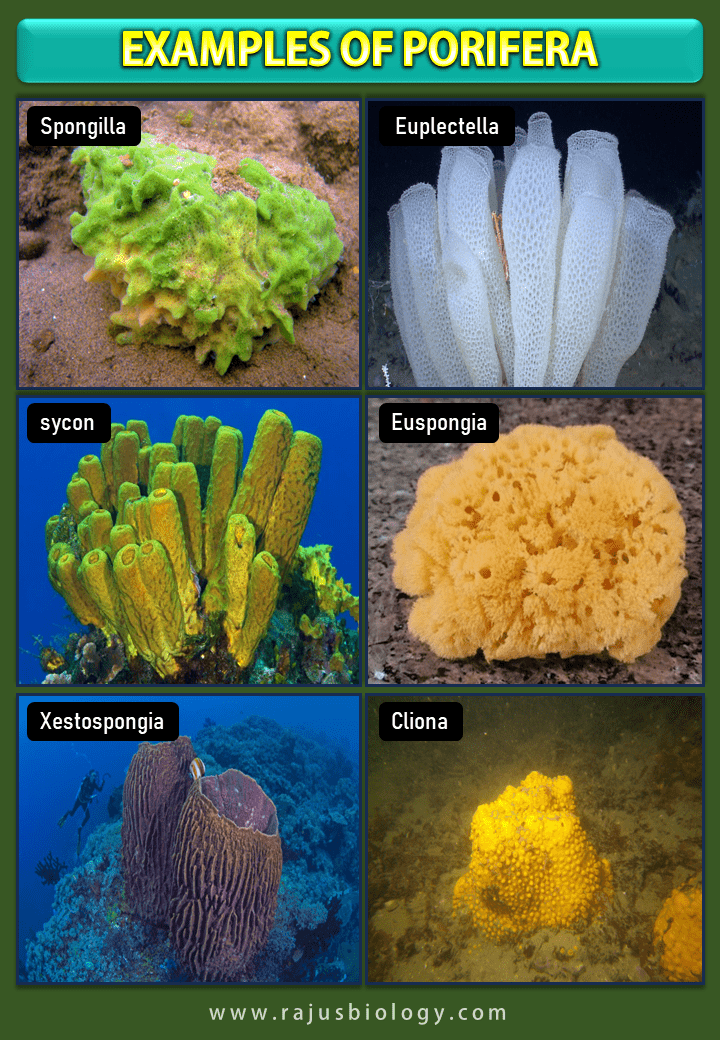In this article we will discuss about Phylum Porifera Characteristics, Classification and Examples
Table of Contents
Phylum Porifera Characteristics
- Phylum Porifera, also known as sponges, are multicellular organisms found mainly in aquatic habitats, including freshwater and marine environments.
- They can live in various depths, from shallow waters to the deep sea, and withstand harsh conditions, such as low oxygen levels.
- Porifera have limited mobility and are often attached to rocks, shells, or other substrates.
- They show a primitive level of organization, with cells performing various functions but not organized into distinct systems.
- Sponges lack true tissues and organs, making them unique among animals.
- Their body is consists of numerous small openings called ostia, allowing water to flow through.
- Sponges are filter feeders, extracting tiny food particles from the water using specialized cells called choanocytes or collar cells.
- Sponges possess a unique cell type called amoebocytes, which play a role in digestion, transportation, and reproduction.
- They possess a unique skeletal structure made of a protein called collagen or a mineral-like substance called spicules, providing support and protection.
- They lack complex sensory organs but can react to stimuli in their environment through specialized cells.
- They reproduce both sexually and asexually. Asexual reproduction occurs through budding, while sexual reproduction involves the release of eggs and sperm.

Phylum Porifera Classification
Porifera can be classified into three main classes:
- Calcarea (Calcispongiae): This class includes sponges with spicules made of calcium carbonate. They are usually small and have a symmetrical body plan. Calcarea sponges are found in shallow marine waters and are often branched or encrusting.
- Hexactinellida (Hydrozoa): These sponges are commonly known as glass sponges due to their delicate, glass-like skeletal structure made of silica. They have six-rayed spicules and are mostly found in deep marine environments, particularly around Antarctica.
- Demospongiae: This is the largest class of sponges and includes over 90% of all known sponge species. Demosponges have either siliceous spicules or a skeleton composed of a protein called spongin. They can be found in diverse habitats, including marine, freshwater, and even terrestrial environments.
In addition to the above classes, there are some other less common classes of porifera, such as Homoscleromorpha, which are small sponges with a simple body structure and siliceous spicules.
Phylum Porifera Examples
- Freshwater sponges (Spongilla): They are inhabits freshwater sponges, found in lakes and streams, attached to logs and submerged plants.
- Venus flower basket (Euplectella): Constructs intricate glass-like skeletons with remarkable strength.
- Calcareous sponges (Sycon): They are mostly asymmetrical in nature and have a water transport canal system.
- Bath sponge (Euspongia): It is a commercially used sponge and found throughout the Mediterranean sea.
- Barrel sponge (Xestospongia): Exhibits a cylindrical shape and can grow exceptionally large.
- Neptune’s cup sponge (Cliona): Capable of boring into calcium carbonate substrates like corals and shells.

FAQs
What is porifera?
Porifera is a phylum of animals commonly known as sponges. They are multicellular, sessile organisms that lack true tissues and organs. Instead, their bodies are supported by a unique network of collagen and mineral-based structures called spicules.
What is canal system in porifera?
The canal system in porifera refers to the complex system of channels or canals found within their bodies, which are used for filter feeding and water circulation. These canals help sponges intake water, filter out food particles, and remove waste.
Which are the larval stages of porifera?
The larval stages of porifera are called parenchymella larvae and amphiblastula larvae. Parenchymella larvae are oval-shaped and have a single layer of cells covering a gelatinous center, while amphiblastula larvae are flagellated and consist of two layers of cells.
Which special cells are present in the body of sponges (porifera)?
Sponges (porifera) possess several special cells that perform specific functions. One of the most important cell types is the choanocyte, which is responsible for generating water currents and capturing food particles. Another significant cell type is the collar cell, which is similar to the choanocyte and assists in capturing food. Additionally, sponges have specialized cells for digestion, reproduction, and skeletal support.
Phylum porifera is classified based on?
Phylum porifera is classified based on various characteristics, including the structure and composition of their spicules, the type and organization of their canal system, and their overall body morphology. Based on these features, porifera is divided into several classes, such as Calcarea (calcium-based spicules), Hexactinellida (silicone-based spicules), and Demospongiae (sponges with spongin fibers or silica spicules).
Read More:
Porifera general characteristics
Phylum Porifera: General Characteristics and Classification
